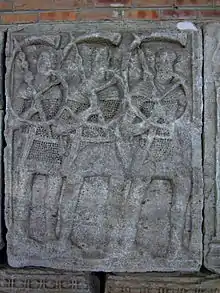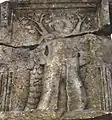Tropaeum Traiani
The Tropaeum Traiani is a monument in Roman Civitas Tropaensium (site of modern Adamclisi, Romania), built in 109 AD in then Moesia Inferior, to commemorate Roman Emperor Trajan's victory over the Dacians, in the winter of 101-102, in the Battle of Adamclisi. Before Trajan's construction, an altar existed there, on the walls of which were inscribed the names of the 3,000 legionaries and auxilia (servicemen) who had died "fighting for the Republic". (Latin: Tropaeum from Greek: Tropaion, source of English: "trophy").

 |
| Part of a series on the |
| Military of ancient Rome |
|---|
|
|
Trajan's monument was inspired by the Augustus mausoleum, and was dedicated to Mars Ultor in AD 107/108. On the monument there were 54 metopes depicting Roman legions fighting against enemies; most of these metopes are preserved in the museum nearby. The monument was supposed to be a warning to the tribes outside this newly conquered province.[1]
By the 20th century, the monument was reduced to a mound of stone and mortar, with a large number of the original bas-reliefs scattered around. The present edifice is a reconstruction dating from 1977. The nearby museum contains many archaeological objects, including parts of the original Roman monument. Of the original 54 metopes, 48 are in the museum and 1 is in Istanbul.
Trophy
The monument was dedicated with a large inscription to Mars Ultor (the avenger). The inscription has been preserved fragmentarily from two sides of the trophy hexagon, and has been reconstructed as follows:
MARTI ULTOR[I]
IM[P(erator)CAES]AR DIVI
NERVA[E] F(ILIUS) N[E]RVA
TRA]IANUS [AUG(USTUS) GERM(ANICUS)]
DAC]I[CU]S PONT(IFEX) MAX(IMUS)
TRIB(UNICIA) POTEST(ATE) XIII
IMP(ERATOR) VI CO(N)S(UL) V P(ater) P(atriae)
?VICTO EXERC]ITU D[ACORUM]
?---- ET SARMATA]RUM----]E 31.[2]
The inscription, which calls Trajan Germanicus from his previous victories in Germany and Dacicus for his new conquest of Dacia, can be translated:
To Mars Ultor,
Caesar the emperor, son of the divine Nerva,
Nerva Trajan Augustus, Germanicus,
Dacicus, Pontifex Maximus,
Plebeian tribune for the 13th time,
[proclaimed] Emperor [by the army] for the 6th time,
Consul for the 5th time, Father the Fatherland,
Conquered the Dacian and the Sarmatian armies ...
 The reconstructed trophy
The reconstructed trophy the original trophy
the original trophy Detail of the trophy: Head of Medusa
Detail of the trophy: Head of Medusa Detail of a falx on the trophy
Detail of a falx on the trophy Roman roof stone tile used for the monument
Roman roof stone tile used for the monument
Metopes
On the monument was a frieze comprising 54 metopes. 48 metopes are hosted in the Adamclisi museum nearby, and one metope is hosted by Istanbul Archaeology Museum, the rest having been lost (There is a reference from Giurescu that two of them fell into Danube River during the transport to Bucharest).[3]

 Metope II
Metope II
 Metope VI: Trajan’s equestrian statue crushing the enemy under the legs of the horse (Gramatopol)
Metope VI: Trajan’s equestrian statue crushing the enemy under the legs of the horse (Gramatopol) Metope IV The Suicide of Decebalus on the Tropaeum -Tiberius Claudius Maximus (according to M.P Spiedel) according to Mihai Gramatopol the metope was erroneously restored by E. Mironescu
Metope IV The Suicide of Decebalus on the Tropaeum -Tiberius Claudius Maximus (according to M.P Spiedel) according to Mihai Gramatopol the metope was erroneously restored by E. Mironescu
 XXIV: the bodies of the Dacians thrown off the cliffs (Gramatopol)
XXIV: the bodies of the Dacians thrown off the cliffs (Gramatopol)

 tabula ansata on the right side of the boss on a soldier shield, metope XXIV from Tropaeum Traiani
tabula ansata on the right side of the boss on a soldier shield, metope XXIV from Tropaeum Traiani

 Adamclisi, imperial metope X: Trajan between two adjutants (according to M. Gramatopol)
Adamclisi, imperial metope X: Trajan between two adjutants (according to M. Gramatopol) Metope XXXV: A Roman Legionary with a mail manica and spear with Dacian falxman
Metope XXXV: A Roman Legionary with a mail manica and spear with Dacian falxman This metope was later reused as part of a fountain, then recovered and placed in the museum
This metope was later reused as part of a fountain, then recovered and placed in the museum
 Metope XXIV: the bodies of the Dacians thrown off the cliffs
Metope XXIV: the bodies of the Dacians thrown off the cliffs
 Metope IX - Barbarian family in a four-wheel cart
Metope IX - Barbarian family in a four-wheel cart


 Metope XLVIII: Germanic POW with Roman Soldier
Metope XLVIII: Germanic POW with Roman Soldier
 Metope XXII: Emperor Trajan[4]
Metope XXII: Emperor Trajan[4]
 Metope XLIV(Gramatopol) changed as Metope XXXIX: Marching "offduty" soldiers
Metope XLIV(Gramatopol) changed as Metope XXXIX: Marching "offduty" soldiers
 XXXI: pursuing the Dacian archers hiding in the trees (Gramatopol)
XXXI: pursuing the Dacian archers hiding in the trees (Gramatopol)




 Metope XVII: Roman equipped with a helmet with broad neckguard, brow guard, cheekpiece and bowl reinforces. Also a short-sleeved scale shirt with double rows of pteryges below the hem and a manica at the sleeve of his right arm, encased in laminated (scale) armour. Curved rectangular shield with raised border, gamma corner symbols and a central boss. The bearded first enemy wears a Phrygian cap and baggy garments, and wields a two-handed falx
Metope XVII: Roman equipped with a helmet with broad neckguard, brow guard, cheekpiece and bowl reinforces. Also a short-sleeved scale shirt with double rows of pteryges below the hem and a manica at the sleeve of his right arm, encased in laminated (scale) armour. Curved rectangular shield with raised border, gamma corner symbols and a central boss. The bearded first enemy wears a Phrygian cap and baggy garments, and wields a two-handed falx




 Emperor Trajan with a Lieutenant[4]
Emperor Trajan with a Lieutenant[4]



 Dacian, Sarmatian, and Germanic captives in the war against the Romans
Dacian, Sarmatian, and Germanic captives in the war against the Romans Dacian, Sarmatian, and Germanic captives in the war against the Romans
Dacian, Sarmatian, and Germanic captives in the war against the Romans Dacian, Sarmatian, and Germanic captives in the war against the Romans
Dacian, Sarmatian, and Germanic captives in the war against the Romans Dacian, Sarmatian, and Germanic captives in the war against the Romans
Dacian, Sarmatian, and Germanic captives in the war against the Romans Dacian, Sarmatian, and Germanic captives in the war against the Romans
Dacian, Sarmatian, and Germanic captives in the war against the Romans Dacian, Sarmatian, and Germanic captives in the war against the Romans
Dacian, Sarmatian, and Germanic captives in the war against the Romans Dacian, Sarmatian, and Germanic captives in the war against the Romans
Dacian, Sarmatian, and Germanic captives in the war against the Romans Dacian, Sarmatian, and Germanic captives in the war against the Romans
Dacian, Sarmatian, and Germanic captives in the war against the Romans Sarmatian, captives in the war against the Romans[4]
Sarmatian, captives in the war against the Romans[4] Dacian, Sarmatian, and Germanic captives in the war against the Romans
Dacian, Sarmatian, and Germanic captives in the war against the Romans Dacian, Sarmatian, and Germanic captives in the war against the Romans
Dacian, Sarmatian, and Germanic captives in the war against the Romans Dacian, Sarmatian, and Germanic captives in the war against the Romans
Dacian, Sarmatian, and Germanic captives in the war against the Romans Dacian, Sarmatian, and Germanic captives in the war against the Romans
Dacian, Sarmatian, and Germanic captives in the war against the Romans Dacian, Sarmatian, and Germanic captives in the war against the Romans
Dacian, Sarmatian, and Germanic captives in the war against the Romans Traian Metope, Istanbul Museum
Traian Metope, Istanbul Museum Germanic captive[4]
Germanic captive[4]
Roman General Tomb
 Roman general Tomb
Roman general Tomb Excavated Roman General Tomb
Excavated Roman General Tomb
Legionaries Memorial
"in honorem et in memoriam fortissimorum virorum qui pugnantes pro republica morte occubuerunt" [2]
1977 Reconstruction
The monument was restored based on a hypothetical reconstruction in 1977.
 Cross-section of the reconstructed Monument
Cross-section of the reconstructed Monument Three different hypothetical reconstructions of the monument
Three different hypothetical reconstructions of the monument 1896 picture
1896 picture Adolf Furtwangler picture
Adolf Furtwangler picture Adolf Furtwangler picture [5]
Adolf Furtwangler picture [5] 1903 Adolf Furtwangler view of reconstructed monument.
1903 Adolf Furtwangler view of reconstructed monument.
Archeological research
In 1837, four Prussian officers, hired by the Ottoman Empire to study the Dobruja strategic situation, performed the first excavations. The team was composed by Heinrich Muhlbach, leading Friedrich Leopold Fischer, Carol Wincke-Olbendorf and Helmuth von Moltke the Elder. They tried to reach the center of the monument by digging a tunnel, nothing was found after the digging.[4]
The monument was also visited by C. W. Wutzer from Bonn University, who recorded a short description of the monument and of some local legends.[4]
The monument was researched by Grigore Tocilescu, O. Benford and G. Niemann, between 1882–1895,[6] George Murnu in 1909, Vasile Parvan stop the researches in 1911, Paul Nicorescu studied the site between 1935–1945, Gheorghe Stefan and Ioan Barnea in 1945. From 1968 the site was researched under Romanian Academy supervision.
Civitas Tropaensium
 Tropaeum Traiani City wall
Tropaeum Traiani City wall A smaller trophy found at Adamclisi, a smaller copy of the original monument which was installed at the eastern city gates during the eras of Constantine and Licinius.
A smaller trophy found at Adamclisi, a smaller copy of the original monument which was installed at the eastern city gates during the eras of Constantine and Licinius.
References
- F.B Florescu Das Siegesdenksmal von Adamclisi: Tropaeum Traiani (1965)
- "Tropaeum Traiani". cimec.ro.
- "1900 Years since the Inauguration of Tropaeum Trajani from Adamclisi - 10 lei silver 2009 - Romanian Coins". romaniancoins.org.
- Vasile Barbu, Cristian Schuster Grigore G. Tocilescu si "Cestiunea Adamclisi" Pagini din Istoria Arheologiei Romanesti ISBN 7-379-25580-0
- https://archive.org/details/dastropaionvonad00furtuoft
- Cimec http://www.cimec.ro/scripts/muzee/id.asp?k=246
Sources
- Das Tropaion von Adamklissi und provinzialrömische Kunst. Von Adolf Furtwängler ... (München, Verlag der K. Akademie, 1903), by Adolf Furtwängler Das Tropaion von Adamklissi und provinzialromische Kunst : Furtwängler, Adolf, 1853-1907 : Free Download, Borrow, and Streaming
- Florea Bobu Florescu, Das Siegesdenkmal von Adamklissi. Tropaeum Traiani. Akademieverlag, Bukarest 1965.
- Wilhelm Jänecke, Die ursprüngliche Gestalt des Tropaion von Adamklissi. Winter, Heidelberg 1919.
- Adrian V. Rădulescu, Das Siegesdenkmal von Adamklissi. Konstanza 1972 und öfter.
- Ian A. Richmond: Adamklissi, en Papers of the British School at Rome 35, 1967, p. 29–39.
- Lino Rossi, A Synoptic Outlook of Adamklissi Metopes and Trajan’s Column Frieze. Factual and Fanciful Topics Revisited, en Athenaeum 85, 1997, p. 471–486.
- Luca Bianchi, Il trofeo di Adamclsi nel quadro dell'arte di stato romana, in Rivista dell'Istituto Nazionale d Archeologia e Storia dell'Arte 61, 2011, p.9-61 Ahttp://arche-o.nolblog.hu/page/2/
- Brian Turner. 2013. "War Losses and Worldview: Re-Viewing the Roman Funerary Altar at Adamclisi." American Journal of Philology 134.2:277-304. DOI: War Losses and Worldview: Re-Viewing the Roman Funerary Altar at Adamclisi.
External links
| Wikimedia Commons has media related to Tropaeum Traiani. |